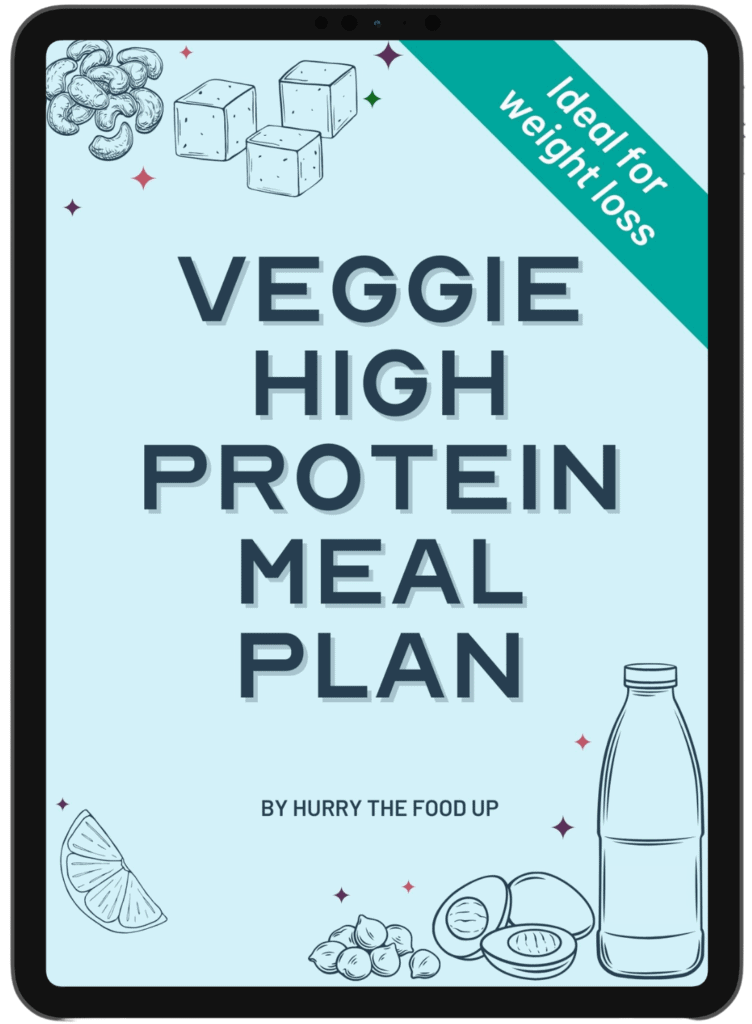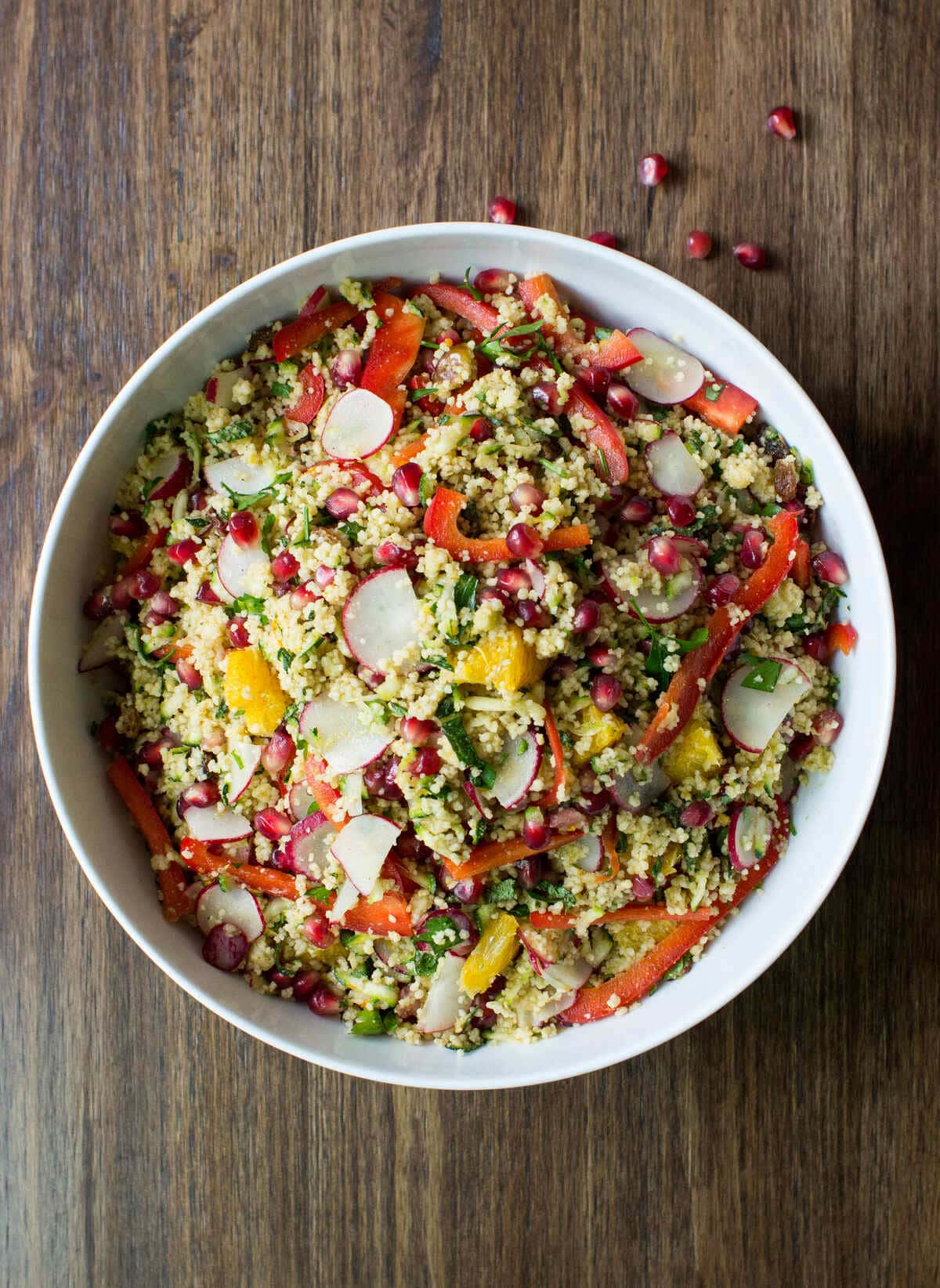Did you know that the common injunction to ‘get your five a day’ actually falls short? Researchers have found that aiming for ten fruits and vegetables a day is optimal. Enter your email & we’ll send it to your inbox. Plus, get great new recipes from us every week! By submitting this form, you consent to receive emails from Hurry the Food Up. Does this seem like an impossible ask? Never fear, this Moroccan salad contains a whopping SIX fruits and vegetables – eat this and you’re well on your way to ten a day!
Ingredients
Couscous Instant couscous is super easy to make and doesn’t require any cooking – just add boiling water and cut down on your cooking time. Olive Oil The oil is key for bringing out the flavours of the vegetables in this moroccan couscous recipe. Ginger Powder Fresh ginger also works well, just chop it finely as large chunks could be overpowering! Cumin Cumin is one of the key spices in this flavourful moroccan couscous salad, but replace the ginger, cumin and paprika for ras al hanout if you have it – a staple of moroccan cuisine! Paprika Powder Paprika creates a lovely warmth with a hint of spice, proving that salads needn’t be bland. Zucchini/ courgette You may be expecting roasted vegetables in this moroccan couscous salad recipe but I use raw veg, and the key is chopping it finely so it’s crunchy but not overwhelmingly so! Pomegranate The crunch of the pomegranate seeds in this salad is so refreshing. Red Pepper Red bell pepper is full of vitamin C and is a perfectly sweet contrast with the citrus flavours of this salad. Orange Nothing goes to waste here as we use the orange zest as well for a citrus tang that finishes this salad perfectly! Fig This is kind of optional as I know how tricky it can be to get hold of fresh figs out of season, but if you can find one, it really elevates this salad. Parsley Fresh herbs really make this salad, and a quarter cup of fresh parsley shouldn’t be underestimated for what it does to the flavours of this salad. Raisins They can be divisive but if you like sweet raisins, chuck them in because they add a lovely texture and sweetness.
How many calories in this Moroccan Couscous Salad?
This Moroccan Couscous Salad contains 468 calories per serving, and it contains 15g protein per serving. Here’s a quick overview of 1 serving: This Moroccan salad is vegan, meaning it’s egg-free and dairy-free, so works perfectly when catering to a large crowd with various diets!
Health Benefits of this Moroccan Couscous Salad
Did you know couscous originates from North Africa, where it is usually used in soup or stew-based meals, rather than salads? But however you eat it, couscous is full of health benefits. Couscous is high in selenium, a trace mineral that is very hard to find in many foods. Selenium is an antioxidant that helps maintain normal cardiovascular function by fighting LDL cholesterol and plaque buildup in our arteries. A single serving of couscous contains over 60% of our daily recommended intake! Selenium may also help improve muscle mass, since studies in selenium have found that selenium deficiency can be the cause of muscle weakness and degradation and fatigue! Finally, the myriad of health benefits found in the vegetables and fruits in this Moroccan Couscous Salad are too numerous to list! However, just a few, such as the high levels of vitamin C in red bell pepper that help boost your immune system, and the high antioxidants in zucchini that help protect your body against free radical damage, are just a couple of reasons why getting your ten a day is such a great goal to aim for! If you enjoy this recipe and want more like it, we’ve got healthy meals plans for three meals a day every day of the week! I could talk more about the benefits of this delicious summer couscous salad, but I don’t want to keep you away from the kitchen any longer!
How to make the best Moroccan Couscous Salad
Couscous prep: boil the water and add to couscous in a large bowl, then cover and set aside for five minutes. Return to couscous and use a fork to loosen up the couscous and add the cumin, ginger, olive oil and paprika powder.
Salad prep: Wash the orange, grate the zest in a small bowl, then chop the orange and add it all to couscous bowl. Deseed the pomegranate, finely dice the zucchini and bell pepper and add to bowl. Now, add the raisins and sliced radishes, if using. Add the fig, if using.
Seasoning: The final but crucial step – flavour time! Wash and chop the parsley and add to salad. If you have any leftover fresh mint or cilantro, add these in too. Season with a pinch of salt and black pepper.
Serving: Toss everything together and present your guests/family/friends with the healthiest, most delicious salad they’ve ever laid eyes upon, prepared and served in a matter of minutes!
Can I make this Moroccan Couscous Salad ahead?
This Moroccan Couscous Salad lends itself perfectly to making ahead of time, as this gives the fresh herbs and spices time to infuse and the flavours to develop. Make it a day ahead for optimum flavour.
How to store and re-heat this Moroccan Couscous Salad?
Store this Moroccan Salad in an airtight container or a bowl covered with cling film for a few days in the fridge. Bring it out of the fridge about twenty minutes before serving to allow the salad to come to room temperature.
What to serve with Moroccan Couscous Salad?
Moroccan Couscous Salad is a great main dish with some pita bread and homemade hummus. Alternatively, serve it alongside these roasted cauliflower steaks with red pepper sauce for a complete meal.
What can I add to couscous for flavor?
Fresh herbs are the best thing to give otherwise plain couscous a boost of flavour. Chop up fresh parsley or coriander, or even mint, and mix through the couscous with a generous drizzle of olive oil. Grated orange zest or lemon zest (or lemon dressing) also gives couscous an irresistible zing, while dried fruit like golden raisins or pine nuts add both flavour and texture.
What is the difference between Israeli couscous and Moroccan couscous?
The difference between Moroccan and Israeli couscous is size! Moroccan couscous is the smallest, thus cooking faster, while Israeli couscous, also known as pearl couscous is larger.
Moroccan Couscous Salad Variations and Alternatives
One of my favourite tips for cooking (if it can even be called that) instant couscous, is using vegetable broth instead of regular boiling water. It adds a great boost of extra flavour, but give the couscous a taste test before adding any more salt. Feel free to replace the spices for Ras El Hanout, if you have it. This is an authentic Moroccan spice blend, but our suggested mix and quantities create an equally tasty, albeit slightly different flavour profile. This recipe uses raw vegetables diced finely, but if you prefer to roast your veg, cover it in a harissa paste for optimum Moroccan flavors before roasting. The textures and flavours will be different to this salad, but this is a great variation to try if you’re feeling adventurous. If you have other fresh ingredients in your fridge that need to be used up, feel free to add them. Other fresh herbs that work well include fresh mint or cilantro, and other vegetables could include red onion or cherry tomatoes.
More great salad recipes
If you’re looking for more out-of-the-ordinary salads, check out this sweet potato and broccoli salad bake. Like this Moroccan couscous salad, it contains six vegetables! Try this lentil and quinoa salad for a salad with complete protein and heaps of flavour.
What our readers are saying
I hope you enjoyed following the recipe card for this delicious, nutritious Moroccan salad. Let me know what you thought of this great recipe in the comments!









